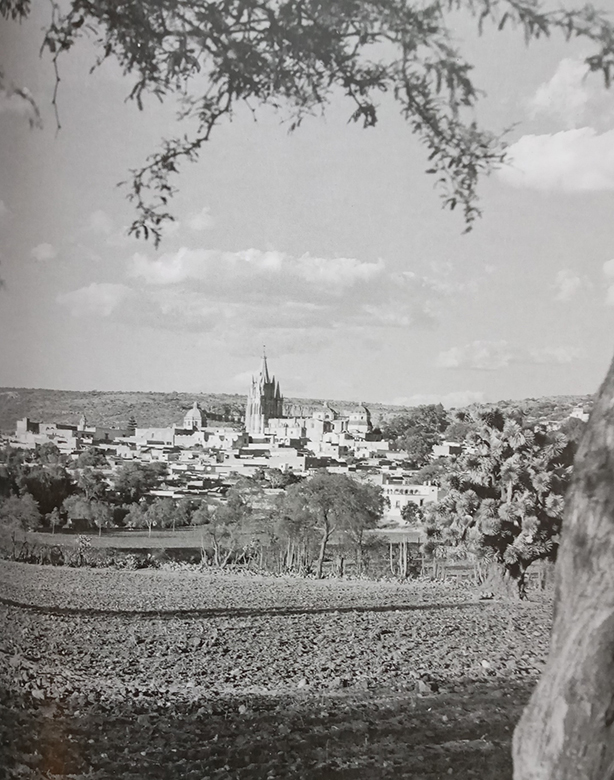
April 30, 2023
by Natalie Taylor
Most of us have had the opportunity to see old photos of San Miguel—iconic shots of the city and of historical events—framed forever by the moment in time in which they were taken. The great majority of these shots were taken by one man, a photographer who made his life's work chronicling the city in images. Arturo Suárez was born in San Miguel de Allende on August 7, 1910 and his 91 years of life spanned a tumultuous era, nationally and locally. Less than one year after his birth, Mexico plunged into a major civil war with the ousting of Dictator Porfirio Diaz, president of the country for three decades. It was the time of Emiliano Zapata, Pancho Villa, and the bloody battles that marked the Mexican Civil War. When that conflict came to an end, the country was once again consumed by the Cristero Wars—brutal clashes between religious and secular factions that went on from 1926 to 1929. It was not until 1934, when Lazaro Cardenas became president, that the country began a journey toward social and economic recovery.
Arturo Suárez encountered violence early in life. When he was a young man, he went to work at Hacienda Tambula, some fifteen kilometers from San Miguel, where he would stay during the week and come home on the weekends. One Saturday, when he could not find transportation, he spotted a horse and "borrowed" it to go home. On the road, he was stopped by military guards because the horse had a brand indicating that it belonged to the military. Arturo was arrested, placed against a wall, and was about to be shot to death for the "theft," when a neighbor recognized him, vouched for him and had him set free. This near-death experience traumatized him so much, that he refused to return to his previous work, and remained with his family in San Miguel.
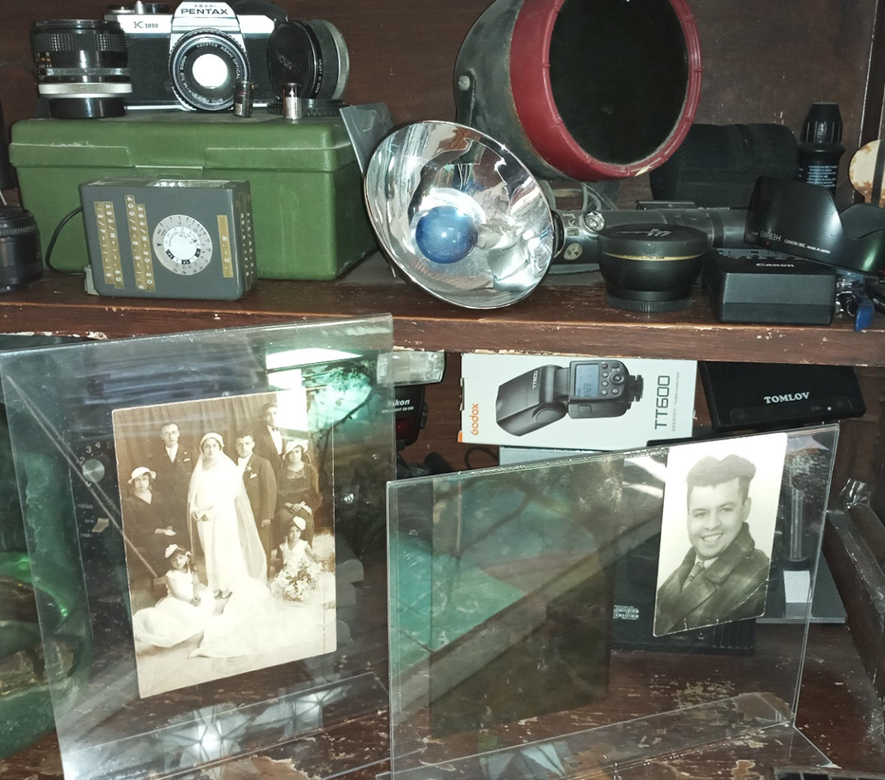
Equipment and photo of young Suárez in the right hand corner
*
Settling in San Miguel was the turning point for Suárez. An itinerant photographer was making the rounds through the city, taking photos of people and events. Arturo was fascinated by the process, and asked to apprentice with the photographer. He learned the trade and eventually opened a general store on Mesones Street, where he also developed photographs, and became the first distributor for Kodak.
The second encounter with violence came in the late 1920s, when he helped a friend aligned with the Cristeros, who was being pursued to be shot. Suárez hid his friend in the trunk of his car, and because he was known by the guards, he was allowed him to pass without inspection. It was a repeat of what Arturo himself had experienced a few years before, and now it was his turn to help save a friend.
After the tumultuous events, the country entered a new and positive era with the presidency of Lazaro Cárdenas in 1934. San Miguel experienced a renaissance with the renovation of old buildings and the founding of the School of Art, by Cossio del Pomar and Stirling Dickinson. Throughout these times, Arturo Suárez took photographs of everything that happened in the city, capturing the landscapes and people of the time.
Arturo Suárez married Antonia Oliden Loredo in 1934 and they had a large family, of which I was fortunate to meet two brothers, Arturo Jr. and Eric. They had just opened a store on Jesus 14 where they display, and sell their father's pictures, and were happy to tell me about him.

The Locos of yore
*
In the Suárez brother's gallery and shop there is a wonderful display of their father's photography paraphernalia and old family pictures. The entire photo collection is impressive, not just in quantity, but because it shows a San Miguel of old—a town changing from historic to contemporary, captured in myriad images of street scenes, religious ceremonies, major openings, and a gallery of historical figures. There are photos of the old Ignacio Ramirez market, the inauguration of the Fabrica la Aurora as an art center, the naming of Parque Juarez, the unveiling of the statue of Fray Juan de San Miguel in front of the Parroquia, and the beginnings of the Locos parade.
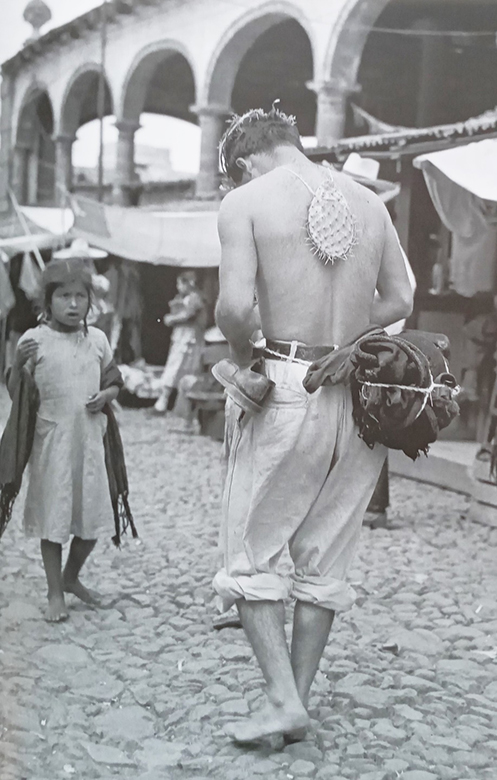
One amazing photo which captures a historical moment, is of a man—his back to us—walking in front of the Ignacio Ramirez Market. He is one of the penitents during Holy Week, who self-inflicts the physical abuses put upon Jesus during his march to the Calvary.
This particular young man walks barefooted, a crown of thorns around his bowed head, and a cactus hangs from his neck, striking and wounding his back as he walks. What is most remarkable, however, is the expression on the face of the little girl coming toward him. It is a mix of surprise and horror, and she seems paralyzed in her tracks as he approaches. The photo snaps motion and stillness in a single shot.
The entire scene is an example of Arturo Suárez's wonderful eye.
The sons explained how their father sometimes took many, many shots until he was satisfied with the result—such as the photo of the transport of the Senor de la Columna (the Lord of the Column), which takes place every year. The one photo of that event that Suárez successfully captured, took him three years to accomplish, because the body of water before the procession never seemed to be right until the one moment when it was.
And then there is the endearing photo of a smiling Stirling Dickinson, driving his famous Jeep in front of the Jardin during a parade. The shot is taken toward the east, along Calle Principal which becomes San Francisco as it rises toward Salida a Queretaro. In those days, that stretch was not yet pedestrian, as it is today. That fact emphasized by the cars parked on the left.
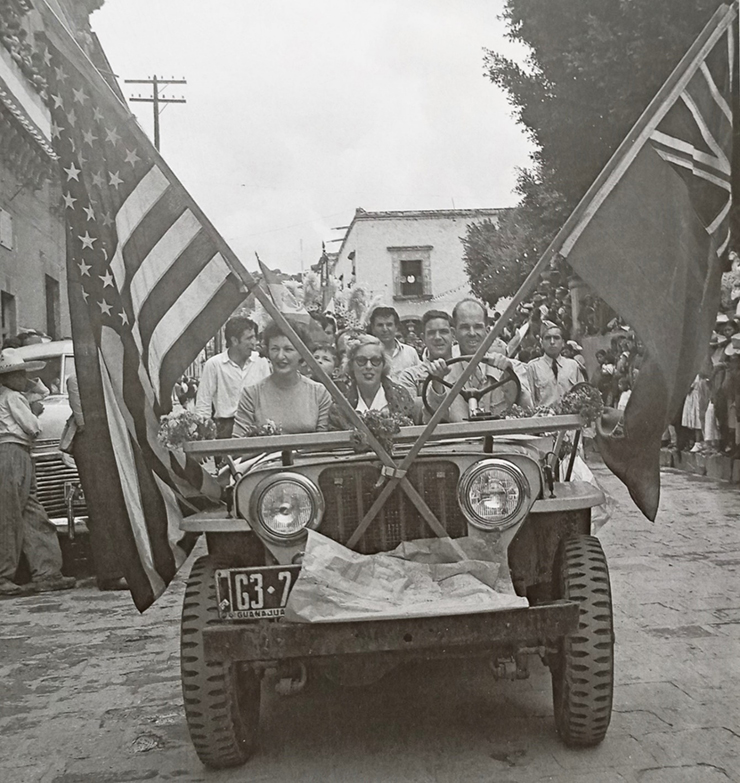
The photos in this article are from the recently inaugurated book "San Miguel de Allende en la mirada de Arturo Suárez," (SMA as seen by Arturo Suárez), published by the state of Guanajuato. The book is not for sale, but can be viewed at the Biblioteca Publica, the Biblioteca Municipal, or at the gallery of the Suárez brothers.
Arturo Suárez lived a decade short of a century, through the metamorphosis of San Miguel from a sleepy town in the Bajío to a major artistic center. He died on February 20, 2001 but left behind a colossal body of work. A history in photos. It's worth visiting the family's newly opened shop on Jesus 14, and seeing these photos for yourself
**************
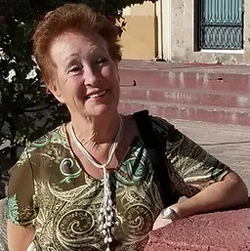
Natalie Taylor, born to Ukrainian parents, grew up in Argentina, where her family fled after WWII. They eventually moved to the U.S., and she spent most of her adult life there. She has a journalism degree, and an MFA in creative writing from Vermont College, Montpelier, VT. Her short stories, and poetry have been published in numerous literary magazines, and she has received several literary awards. She and her husband currently reside in San Miguel, where she has a weekly column in Atención, for which she also does translations. She has two books about San Miguel, available on Amazon or at the Tesoros Book Store: "Of All the Towns in All the World," and "SMA Self-Guided Historical Walking Tour." Her memoir, "The Tango House," will be coming out soon.
www.natalietaylor.org
**************
*****
Please contribute to Lokkal,
SMA's online collective:
 ***
***
Discover Lokkal:
Watch the two-minute video below.
Then, just below that, scroll down SMA's Community Wall.
Mission

Visit SMA's Social Network
